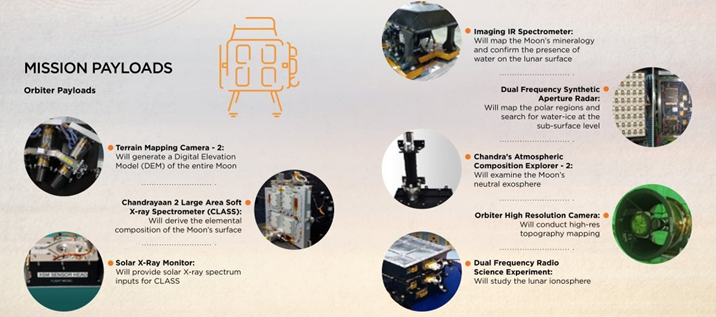CHANDRAYAAN’S PRAGYAN ROVER OFFERS EVIDENCE OF MAGMA OCEAN ON YOUNG MOON
Relevance: GS – 3 : Science and Technology – developments.
Why in the news?
- Pragyan, India’s Chandrayaan-3 mission rover, moved about 100 meters from the landing zone in two weeks.
- During the trip, it occasionally stops to use its instruments to check the moon dust.
- As the long lunar night approached, Pragyan led the crew of the Indian Space Research Organization (ISRO).
- Sub-zero temperatures on the moon proved too harsh for the suitcase-sized rover.
- After landing for fourteen days, Pragyan slept for the last time, finishing its work.
Chandrayaan-3 Mission:
- The Vikram lander of the Chandrayaan-3 mission successfully landed on the moon on August 23, 2023, just after 6 pm IST.
- A few hours later the Pragyan rover was released and traveled about 100 meters over the next two weeks, moving cautiously to avoid any obstacles that could jeopardize the mission
- Importance of location:
- Vikram’s landing site, Statio Shivashakti, is located about 300 kilometers from the South Pole Aitken Basin, the largest impact crater in the solar system. The basin is about 8 km deep and 2500 km wide.
- Scientists believe the lake was created by a massive meteor, which could dislodge material from the moon’s upper mantle and disperse into the atmosphere, possibly powering Statio Shiva Shakti
- Importance of the landing mission:
- Vadawele emphasized that such detailed observations would have been impossible in a typical orbital mission, as orbiter pilots can only see the composition of the soil, not its density
- Launching it at altitude allowed for better exploration, providing “ground truth” of the moon’s south pole region, which had higher levels of information than could be obtained by an orbiter.
Achievements of Pragyan Rover in Chandrayaan-3 Mission
- Pragyan met all the expectations of ISRO and successfully completed its science objectives in two weeks. The rover studied the lunar terrain in depth and returned valuable data to Earth, making way for new discoveries.
- Key findings include:
- Sulfur found in lunar soil.
- Confirmation of small rocks around the edge of the crater near Shiva Shakti Point, the touch-down point of the Chandrayaan-3 spacecraft.
- In a study published in Nature on August 21, Pragyan reported the discovery of ferroan anorthosite in lunar soil.
- The findings are significant because they are consistent with findings in the US. Apollo and Soviet lunar missions in the 1960s, which also showed alignment of this rock near the lunar equator
- Pragyan sources suggest that these anorthosite rocks could be the remnants of an ancient magma ocean that covered the surface of the Moon about 40 million years ago, providing insight into the Moon’s origin.
- Pragyan’s Observations:
- Throughout the journey, Pragyan made 23 stops around Statio Shivashakti to observe and analyze lunar dust with his instruments.
- The APXS instrument’s travel camera near the rover fired X-ray alpha particles at the dust to determine its chemical and mineral composition.
- During its stop that lasted a few minutes to two hours, the Pragyan APXS instrument collected readings indicating the presence of ferrous anorthosites
- The instrument also detected debris from other ancient monuments scattered along the Pragyan’s Path, leading to greater understanding of the moon’s geologic history
The Moon’s Origins Findings by Pragyan Rover
Ferroan Anorthosite on the Moon:
- Santosh Vadawale, the principal investigator of Pragyan’s Alpha Particle X-ray Spectrometer (APXS) instrument, highlighted that ferroan anorthosite rocks, common on Earth, are also found on the Moon.
- The prevailing theory suggests that the Moon was formed from the debris of a collision between the early Earth and a rogue planetary body.
- This event led to a molten lunar surface, where minerals crystallized as the lava cooled, forming various rocks, including ferroan anorthosite.
Weathering on the Moon:
- Over centuries, meteorites bombarded the Moon’s surface, breaking down rocks like ferroan anorthosite into fine dust.
- Unlike Earth, the Moon’s thin atmosphere and lack of volcanic activity mean that meteors reach the surface unimpeded, and the surface isn’t replenished with new rocks over time.
Description of dust in Statio Shiva Shakti
Dust containing magnesium:
- Later meteor impacts on the Moon likely fused this magnesium-rich material with anorthosite dust to homogenize it.
- Santosh Vadawele and his team were relieved to learn that the Pragyan data highlighted unusually high magnesium concentrations, supporting the magma ocean theories and impact hypotheses
Data replication and future research:
- The findings, although significant, need to be replicated with data from other instruments.
- Researchers have already done so with data from Chandrayaan-1 and Chandrayaan-2, and are now analyzing data from other space missions.
- Vadawele said that teams are actively working on new research projects, including high levels of light elements in the lunar soil, which could provide new clues to understanding lunar composition
- More Data from the rover’s signature is getting compiled and its APXS and LIBS instrument.
National Space Day:
- After the successful landing of Chandrayaan-3 on August 23, 2023, Prime Minister Narendra Modi declared this date as India’s new ‘National Space Day’.
- When the paper was published:
- Dr Santosh Wadawale said their paper was deliberately published before the first National Space Day commemoration.
- He said the Nature editorial board was suggested to publish the paper by August 12, the birth anniversary of Vikram Sarabhai, the father of India’s space program
Alternative articles
https://universalinstitutions.com/chandrayaan-3s-first-findings-insights-into-lunar-history/
Mains question
To understand the origin of the Moon and its implications for future Lunar exploration, discuss the significance of the findings of the Chandrayaan-3 mission, especially the discovery of ferrone anorthosites. (250 words)




